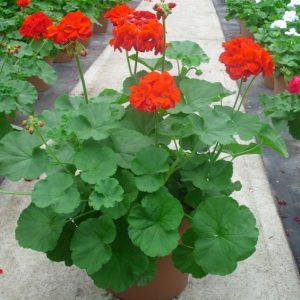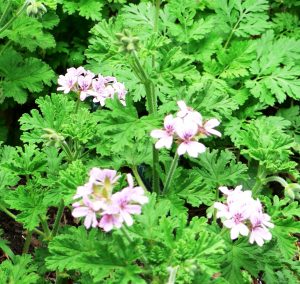by Ken Lain, the mountain gardener

Mountain famous for continual blooms spring through autumn with just a bit of care. The perfect cottage garden flower ideally grown in containers, hanging baskets, or raised beds. Sunshine Geraniums make gardening brighter! Feed twice monthly with Watters ‘Flower Power’ for a riotous bloom all season long.
No garden is complete without geraniums (Pelargonium), and they are so easy to grow that no gardener should be caught without one. Geraniums can be grown right in the garden in zones 8–11 where winters are mild, but they bloom even better where they are slightly root-boun, tightly packed, like in a container. When grown in pots, geraniums can also be relocated at a moment’s notice, whether to show them off near an entry, to bring them indoors during surprise freezes, or to move them to a shadier spot in the hottest days of summer.
Types of and Uses for Geraniums
A South African perennial is available in a multitude of species and hybrids, each with unique traits. Zonal geraniums are grown for their variety of colorful flowers and velvety rounded leaves that feature bands of color arranged in zones, hence the name.

Scented geraniums are beloved for the fragrance of their finely-cut leaves. When brushed up against the foliage sends strong scents of rose, mint, chocolate, and lemon fragrant, the help repel insects like mosquitos and flys from backyard BBQ.
All geraniums need protection from winter freezes, summer heat, and soggy soil caused by overwatering. As long as you follow a few simple tips, geraniums are some of the most natural and most prolific flowers you can grow.
Sun – They Like it Bright
Geraniums need the sun to bloom well. A bright eastern to a west location is ideal. Their blooms show longer in summer with some mid-day protection from the hottest part of the day. They even bloom well under a South facing entrance under the overhang, they just need a bright mountain location.
Although geraniums do require moisture, they rot in pots without proper drainage or stay too soggy. Water only when the top inch of garden soil is dry, and make sure that moisture can quickly drain away through holes of a container. Geraniums are relatively drought-tolerant and survive with little care. Water before the roots completely dry out.
Keep Geraniums Blooming
Keep geraniums in bloom by pinching spent flowers for the plant. Geraniums stay full and bushy with an occasionally pruning back leggy new growth in mid-summer. Geraniums like to be root-bound; repot only when necessary into larger containers; only use a container one size larger than the current pot. Geraniums are heavy feeders, so fertilize twice per month with Watters ‘Flower Power’ to encourage continual blooms.
Protect From Freezes
Gardeners in zones 8–11 can get away covering their geraniums on frosty nights, but everyone else should overwinter this annual flower indoors. Bring your geraniums inside before the first hard frost and place them in a sunny window, or let them go dormant in a cool, dark place. An insulated garage with bright window works as well, just don’t allow the roots to freeze solid. Some gardeners cut the foliage back and store them in an unfinished basement or crawlspace through winter as well, just don’t allow the roots freeze solid.
Keeping Them Healthy Indoors
Geraniums can be grown indoors through winter. They are a bright and cheery addition through drab winter days. Keen indoor temperatures above 50 degrees Fahrenheit, allow the soil’s top inch or two to dry out before watering, and keep an eye out for diseases or damaged leaves.
Pest
Indoors or out you need to watch for the Top 10 Houseplant Pest that affects Geraniums. Keep a close eye for evidence of spider mites. You may see parched leaves, webbing, or tiny specks that resemble spiders when seen under a magnifying glass. Spider mites are best treated early with Triple Action. Repeat this organic spray at 10-day intervals until the plant begins to grow and bloom again.
Budworms can eat the flowers specifically in mid-summer. This tiny caterpillar is hard to spot, yet easy to kill. Watch geraniums that look healthy and full, but without flowers. Spray with BT by Bonide, to eliminate this pest. Encourage new flower buds with the feeding of Flower Power again. Repeat at 10-day intervals until the plants come back into bloom.
That’s it. Just water, feed, and keep geraniums from freezing. You’ll find they are some of the most carefree and rewarding flowers grown in a container, raised beds or gardens, indoors or out.
Companion Plants Grown with Geraniums for a Stunning Backyard
The perfect mountain perennial with huge fiery flowers on a compact plant. She loves the heat and super drought hardy. You can count on this bloomer to show off all summer long in raised beds, containers, or directly in the ground. Javelina and rabbit proof, this bloomer is a ‘must-have.’ Arizona plant.
Just plant in a sunny spot and enjoy! We’ve married the beauty of long stem roses with the Easy-care of shrub roses for landscape color like no other plant in the backyard. Choose fragrant reds, radiant pinks, corals, vivacious yellows, and stately whites. Extremely fragrant and only found locally at Watters.
Wind is no problem for this evergreen bloomer. Rose, Pink to white flowers cover this spring bloomer that often repeat blooms in fall. The dark blue berries adorn this compact bush that takes the wind and soaks up the sun like a native. Perfect for low maintenance gardening with virtually no pruning ever. Every backyard should have at least one.
A super vigorous vine with dangling stalks of fragrant flowers appear in early spring. Blooms are often followed by showy, 4″ purple edible fruit . . .yum! She proliferates up arbors, pergolas, fences, and stunning as a ground cover to retain hills. One of the fastest-growing evergreen vines for mountain gardens.
Purple Robe Locust Tree
Incredible, long clusters of purple flowers in May that look just like Wisteria flowers hanging from this local bloomer. The 8″ inch fragrant clusters cover the tree profusely! Super hardy and drought tolerant with a brisk growth rate of 2 feet in one year. It’s the perfect summer shade tree.

